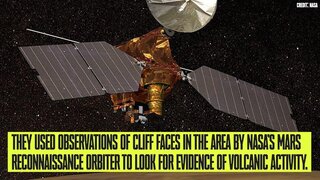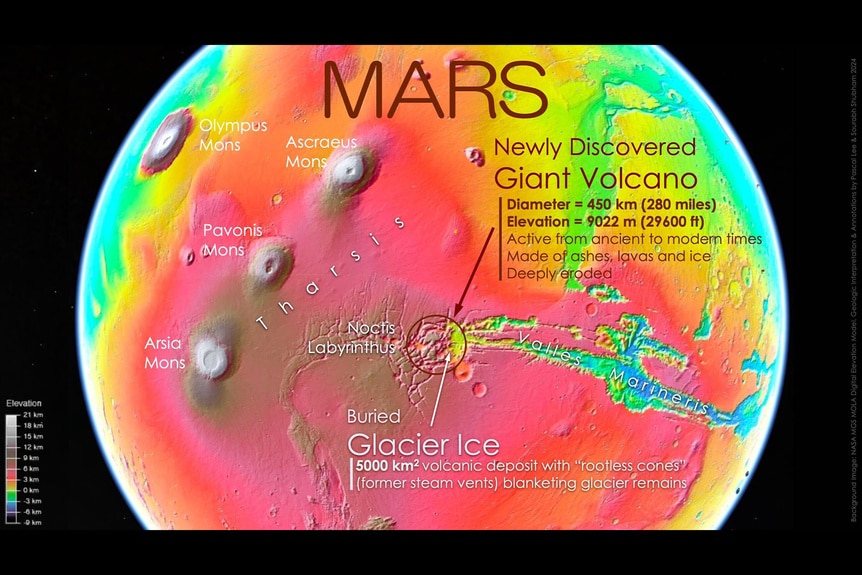Create a free profile to get unlimited access to exclusive videos, sweepstakes, and more!
Giant "Hidden" Volcano Taller Than Everest Discovered on Mars
And it's not even close to the biggest volcano on Mars.
In 1997, Pierce Brosnan traded in his tuxedo, gadgets, and career as the world’s greatest spy for a seismometer and khakis in Dante’s Peak. He sets up in the fictional town of the same name, nestled at the base of a cozy mountain turned killer volcano. What made the eruption at Dante’s Peak so deadly is that no one saw what was right in front of them until it was too late.
Recently, scientists at the SETI Institute had a similar if less deadly experience while studying Mars. While looking for evidence of ancient ice flows, researchers stumbled onto the remains of a huge, previously unknown volcano on the Red Planet. The discovery was published and announced at the 55th Lunar and Planetary Science Conference.
A Newly Discovered Martian Volcano Taller Than Everest
Given the barren landscape and minimal cloud cover, this volcano has been practically staring us in the face for decades, but significant erosion disguised it from view until now. Researchers were studying a region between Noctis Labyrinthus and Valles Marineris, where an ancient glacier might have once gouged the face of the planet.
“We were examining the geology of an area where we had found the remains of a glacier last year when we realized we were inside a huge and deeply eroded volcano,” said planetary scientist and study author Dr. Pascal Lee, in a statement.
For More on Mars:
NASA Discovery Could Mean Mars Had Life-Supporting Hydrothermal Vents
NASA Seeking Applicants for Next CHAPEA Simulated Mars Mission
NASA's Perseverance Spies Damaged Ingenuity Helicopter on Mars
What’s left of the once great volcano is mostly elevated mesas arranged in an arc and the collapsed remains of the caldera. Researchers also found evidence of lava flows, pyroclastic deposits, and hydrated mineral deposits nearby. The volcano, provisionally designated “Noctis volcano” while it’s waiting for an official name, is huge by Earth standards. Its base sprawls across 280 miles (450 kilometers) and its peak stretches 29,600 feet high.
The Noctis volcano is about 500 feet taller than Mount Everest, and it’s not even close to the biggest volcano on Mars. Earth’s planetary little brother has never been tectonically active, its surface plates don’t move around like Earth’s do, but it has been volcanically active and might still be today. On Earth, tectonic plates glide over top of volcanic hot spots, often creating chains of volcanoes like the Hawaiian Islands. That wasn’t possible on Mars, so volcanoes had an opportunity to reach truly mind-blowing proportions.
The geological crown jewel of Mars and the largest mountain in the solar system is the brain-breaking Olympus Mons. It sits on a foundation 374 miles (600 kilometers) across, a Martian mountain roughly the size of Arizona. Its immense base supports a truly stupendous geological construction; where the Noctis volcano and Earth’s Mount Everest both stand about 5.5 miles tall, Olympus Mons reaches 16 miles (25 kilometers) into the dusty Martian sky.
Back at the equator, scientists are learning about Mars’ history from the rocks it left behind. The Noctis volcano was seemingly cut down in its youth through a complex series of erosion events. The region has experienced some uplift, which researchers believe created fractures in the volcano. Later, lava rose through those cracks, widening and further stressing them. Lastly, glacial migrations and melting ice jostled the already weakened structure and it collapsed.
The discovery also provides a new potential site in the search for alien life. The combination of water ice and warmth from the volcano might have provided an ideal environment for Martian microbes a few billion years ago. To find out, we’re going to have to send a mission there to check it out ourselves.
If Pierce Brosnan tells you to run, listen! Catch Dante’s Peak, available from Universal Pictures.































